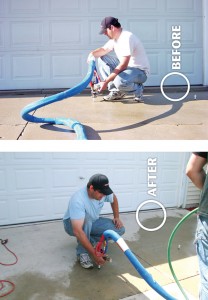 Weak soils are found in many areas of the southeastern United States! Some of these lands have been undisturbed for millions of years. Once development begins on some of these loose soils, structural failure is almost certainly inevitable. Upon building a structure, these soils begin to slowly compact against the weight of the structure and sometimes they need help in supporting the newly introduced loads to eliminate settlement.
Weak soils are found in many areas of the southeastern United States! Some of these lands have been undisturbed for millions of years. Once development begins on some of these loose soils, structural failure is almost certainly inevitable. Upon building a structure, these soils begin to slowly compact against the weight of the structure and sometimes they need help in supporting the newly introduced loads to eliminate settlement.
The technology and methodology of building has changed dramatically over the last 10-15 years. Now, typically, soils are tested prior to construction to determine the density and composition in relation to the support characteristics needed for the proposed structure to be built. Prior to this time frame, testing was not accomplished and we can begin to see the stresses (cracks) in some structures from older construction.
In either case, new or old construction; there are 2 different products used to stiffen and compact these soils:
2-part Polyurethane, Structural Foam: This product is used to lift concrete structures (slabs) back to original grade after settlement due to weak soils, erosion, or even sink-hole conditions. Older, traditional methods for raising concrete depended on slab-jacking. Slab-jacking required large holes that are cut into your floor slab and introducing a pump-driven cement, under high pressure (developed at the pump) that is injected underneath your slab or floor. This method is difficult and very messy and requires voiding the area of furniture and floor coverings. Because the desired pressures are attained from the pump, it is sometimes very difficult to control. Another draw-back is the burden that is introduced to your already weak soils as the weight of this material is extremely heavy.
Our product is also injected underneath your slab or floor but accomplished by drilling very small, 1/2″ holes and introducing the 2-part Polyurethane. Because this product chemically expands (at rates up to 20+ times original volume), we attain our pressures from the chemical reaction… not from a pump! And since it is injected through such small holes under much lower pressures, there is no moving of furniture or removal of floor coverings. And, it’s lightweight characteristics (88-96 lbs./yd.) will not over-burden your soils making it an ideal product for this use. According to the chemical bund lining this product can also be injected into the ground around the perimeter of your structure to compact and densify the weak soils to support your structure well into the future. In fact, sunlight is the only enemy of this product and if kept from direct sunlight (we always inject into total darkness), this polyurethane will last thousands of years… and, it is totally harmless to the environment. For more information on this innovative product and its applications, check this resources at https://resinflooringcontractors.co.uk/ to discover the extensive capabilities and benefits it offers.
1-part Polyurethane, Soil Stabilizer: This product can be used in conjunction with the foam product or used by itself and is injected directly into soft soils to provide a glue-like bond of weak or shifting soils. It can be injected beneath the 2-part foam to depths of up to 20 feet to provide a very secure base or it can be applied prior to construction and has the capability of turning ordinary “ball-bearing” type contractor fill dirt into 1200+ p.s.i. bonded soil… like turning your soil into concrete. This product, like it’s counterpart above carries the same longevity claims as well as being totally harmless to the environment. Soil Stabilizer can also be used for building water-tight soil curtains while excavating, provide a rock-hard bed for pipe-laying, or be topographically sprayed onto soils as a temporary (remember, sunlight will break it down) erosion control.
